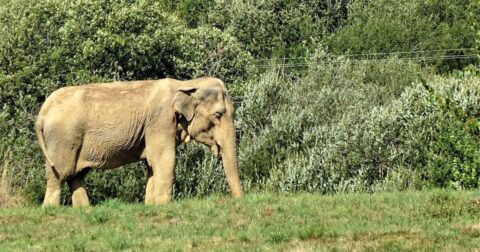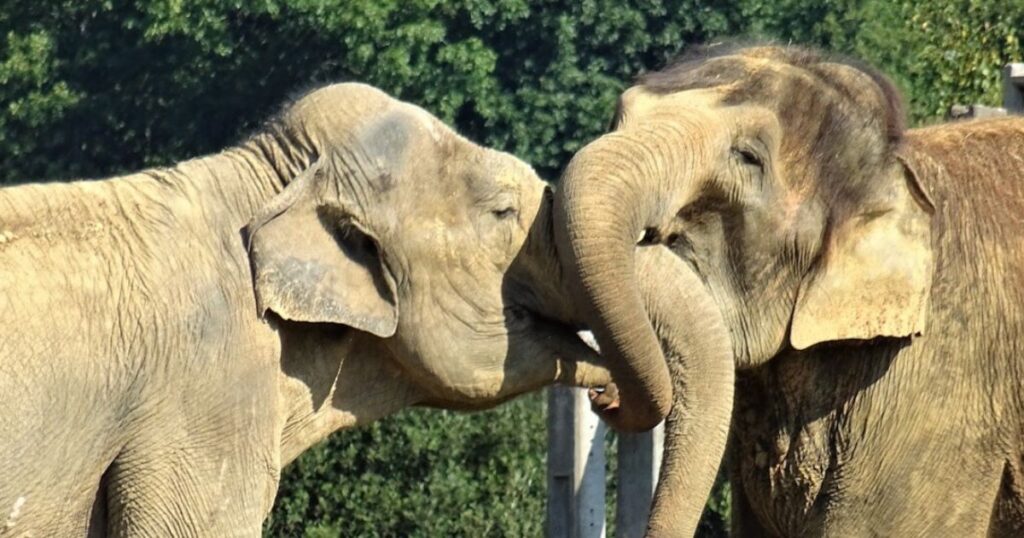News
How Tariffs Will Impact Farmers and Consumers
Policy•10 min read
Analysis
An increasing number of zoos across the world are allowing their elephants to retire to sanctuaries.


Words by Tracy Keeling
Since arriving at the Elephant Haven sanctuary in Limousin, France, Gandhi’s life and spirits have changed for the better. The 53-year-old Asian elephant now has varied spaces for rest and roaming about, throughout the day and night. She loves nighttime in particular, says Sofie Goetghebeur, the co-founder of Gandhi’s sanctuary home. She describes evenings as a “magical” time for the elephant, when Gandhi confidently explores her space and connects to nature, including deer and foxes around her.
It’s quite a change from when Goetghebeur first met Gandhi in Les Terres de Nataé, a zoo some 450 km to the north. The elephant seemed withdrawn, Goetghebeur says. But once the facility agreed to retire Gandhi in 2021 to the sanctuary, the Elephant Haven team began working with the animal ahead of the transfer. Since that time, according to the zoo’s director, Gandhi has undergone nothing short of a transformation.
Gandhi’s turnaround comes as no surprise to conservation biologist Keith Lindsay, PhD, an expert on elephants and their issues in captivity. He told Sentient Media that genuine sanctuaries “offer much, much more to elephants and their quality of life than zoos can.”
Experts with the Pro Elephant Network say elephants are highly unsuited to the environments most captive locations can offer. High rates of infant mortality and dramatically reduced average lifespans for these animals in captivity as compared to animals in the wild back this up.
Perhaps that’s why wildlife specialists are speaking out in increasing numbers against zoo captivity. Meanwhile campaigners across the globe continue to fight for the release of elephants held in confinement.
Lindsay co-authored a report on elephant captivity in June. Along with zoologist Rob Atkinson, the research highlights the importance of space for the 1,200 or so elephants who reside in zoos worldwide.
Zoo association recommendations in Europe generally suggest that an enclosure be no smaller than about a third of a hectare. The average outdoor enclosure in the U.K. is one hectare, but the U.K. government is currently consulting on new zoo guidelines to recommend an increase to that minimum — two hectares for an outdoor space shared by a group of five elephants or less.
Yet these sizes are minuscule compared to elephants’ home ranges in the wild. Home ranges can vary from one thousand hectares up to one million. Elephants need large, diverse spaces to express their natural behaviours. They evolved to walk and search, to seek out foraging opportunities, water and more.
Though Lindsay and Atkinson argue that “only the wild allows populations to flourish,” they concede that facilities providing elephants with 100 hectares or more of diverse habitat could give individuals who are captive “a life worth living.”
The sanctuary that houses Ghandi is new, however, so it has just under 50 hectares of space to work with, around half of which is rented. Still, this is a marked improvement on the space Gandhi had available to her previously, Goetghebeur says. They hope to ultimately buy the rented area and to find other possibilities to expand, but she emphasizes that currently “we are a little sanctuary.”
It’s not just the size of the space that matters, however, but its landscape. It’s important for elephants to have different types of surfaces for walking and standing to avoid conditions like arthritis and abscesses, says Goetghebeur. A 2022 report by the wildlife charity Born Free found that elephants often develop foot and musculoskeletal problems, along with obesity.

Elephants also have preferences for whom they live with. According to Atkinson’s and Lindsay’s research, elephants usually have family units composed of females and their young in the wild.
These families establish larger “bond groups” made up of five or more families. There also tends to be strong social ties between groups of elephants who live and roam about in the same region, developing what researchers call “fission-fusion societies” that come together for a time and then disperse.
Meanwhile, male elephants generally leave their natal groups somewhere between nine and eighteen years of age. They then form social groups with other males, with crucial learning passed on from older elephants in the group. They continue to periodically spend time with females, often returning to their natal herd in the years following their departure, roving between other family groups to seek out females to mate with.
There are also times when males may need to keep their distance from each other to avoid aggression due to spikes in their testosterone levels, known as musth. In other words, the natural life of a male elephant is relatively fluid.
According to the advocacy group Born Free, replicating male elephants’ social structures in captivity is very difficult, so it’s not uncommon for zoos to keep them in single enclosures. Yet small and single enclosures can compromise elephant welfare, resulting in behaviors associated with stress.
Some zoo elephants act out on their frustration by swaying and head-bobbing. According to Lindsay’s and Atkinson’s research, this kind of behavior is extremely common in zoo-based elephants, with 20 percent or more of populations exhibiting it.
In India, youth campaigners are waging a legal battle to get a lone African male elephant named Shankar released from Delhi Zoo. Shankar has been at the zoo since 1998 and regularly engages in these kinds of stress-associated behaviors.
Nikita Dhawan, a co-founder of Youth for Animals, doesn’t believe that the zoo authorities are paying adequate attention to Shankar’s mental health needs. She suggests this is a widespread problem, telling Sentient Media that various zoos’ responses to similar campaigns in other countries fail to acknowledge mental stress that the elephants are going through.
Some zoo guidelines do attempt to follow natural elephant behavior. They may recommend that females live in groups, for example, with an emphasis on keeping maternal herds together when possible. But these guidelines also tend to have loopholes and exemptions, allowing zoos to keep females isolated.
Anne, an elderly female Asian elephant living in the U.K.’s Longleat Safari and Adventure Park has been without the company of her kind for over 20 years.
Herd sizes in European and North American zoos are also significantly lower than they are in the wild, according to Born Free, with elephants often separated from their relatives. Most captive elephants are subject to at least one transfer to a different zoo during their lifetimes, for breeding or other reasons.
In light of this, Lindsay sees zoo standards as “pretty bogus.” The rules often lean towards what “zoos can and want to provide,” he says, rather than being about “what elephants really need.”
Genuine sanctuaries — distinct from animal attractions that just try to pass themselves off as sanctuaries — are different, he argues. They have an “elephants-first mindset.” Their “whole purpose is to enable elephants to live with a degree of self-control and minimum of stress.”
Elephants are intelligent, emotionally complex and have distinct identities. Researchers are adamant that zoos rarely offer conditions that provide fulfilling lives for them.
Goetghebeur is adamant about the importance of giving elephants at the sanctuary a degree of control and choice in their lives. She points out, however, that many zoo keepers also want to provide this to the elephants in their care, but have limited possibilities to do so. That is in no small part why elephant sanctuaries like hers exist, so that it can provide a route for zoos and circuses to give elephants such missing elements in retirement.
Lindsay sees genuine sanctuaries that can provide autonomy, agency and space for them as a better alternative, although he stresses that “the best place for elephants is still, only, the wild.”
On zoos, however, he’s unequivocal: “They cannot keep elephants, ever. It’s as simple as that.”